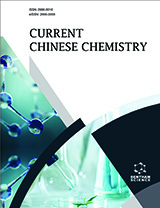- Home
- A-Z Publications
- Current Chinese Chemistry
- Issue Home
Current Chinese Chemistry - Current Issue
Volume 2, Issue 3, 2022
-
-
Biological Importance and Pharmacological Activities of Meranzin and Meranzin Hydrate against Human Disorders
More LessAuthors: Dinesh Kumar Patel and Kanika PatelBackground: Herbal plant-based products and their derived phytochemicals have been used in the complementary and alternative systems of medicine for the treatment of human disorders. Vegetables, fruits, seeds, nuts, coffee, tea, and wine contain significant amounts of coumarin class phytochemicals. Coumarin is found to be present in cassia leaf oil, cinnamon bark oil, lavender oil, and microorganism-derived drugs.Me Read More
-
-
-
Hologram QSAR and Topomer CoMFA Study on Naphthyridone Derivatives as ATAD2 Bromodomain Inhibitors
More LessAuthors: Zhenxia Lv, Jing Ren, Shaobo Zhang, Bokai Wang, Yuxin Peng, Wu Yao and Jintao YuanBackground: ATAD2 is closely related to the occurrence and proliferation of many tumors. Thus, exploring ATAD2 inhibitors is greatly significant for the prevention and treatment of tumors. In this study, the quantitative structure–activity relationship (QSAR) analyses of 57 naphthyridone derivatives were conducted using hologram quantitative structure–activity relationship (HQSAR) and topomer comparative molecular fie Read More
-
-
-
A Mechanistic Study of the Antibacterial Activity of Phytoconstituents of Pyracantha crenulata by using Molecular Docking Studies
More LessAuthors: Gunjan Bisht, Ankit Kumar Singh, Adarsh Kumar and Pradeep KumarBackground: Bacteria cause various infections and are a threat to the health system. This threat is increased due to the resistance of bacteria towards antibacterial drugs. Plants are an important source of drugs including antibacterial agents. Pyracantha crenulata is one important plant known for its different medicinal uses. It contains different phytoconstituents responsible for its medicinal properties.In cholera, ToxT (PD Read More
-
-
-
Synthesis, Characterization, Textile Dyeing Study and Antimicrobial Activity of 3-(1H-benzo[d]imidazol-2-yl)-2-chloroquinoline
More LessAuthors: Minaxi S. Maru, Varinder Kaur, Jagriti Behal and Samriti VaidBackground: Benzimidazoles are important heterocyclic compounds having significant attention in the pharmacological industry due to their various biological and dying properties.Objective: 3-(1H-benzo[d]imidazol-2-yl)-2-chloroquinoline, a heterocyclic dye (1), was prepared using o-phenylenediamine and 2-chloroquinoline-3-carbaldehyde in the presence of ceric ammonium nitrate catalyst and hydrogen peroxide un Read More
-
Volumes & issues
Most Read This Month Most Read RSS feed
Article
content/journals/ccchem
Journal
10
5
false
en


